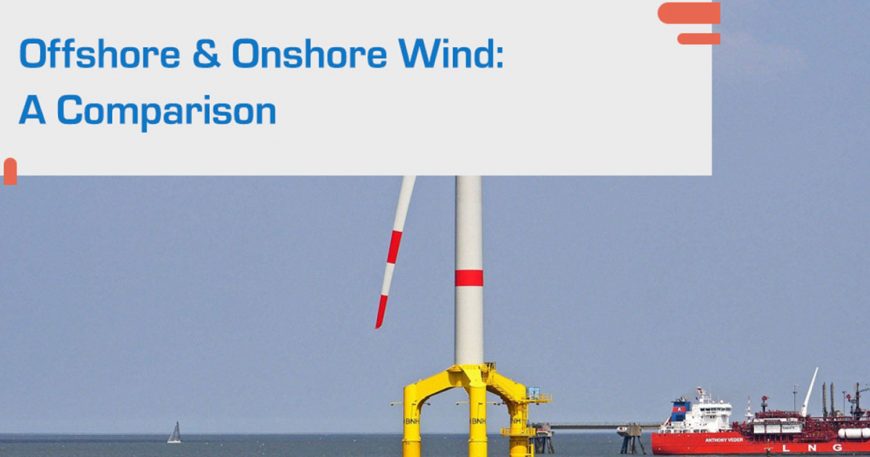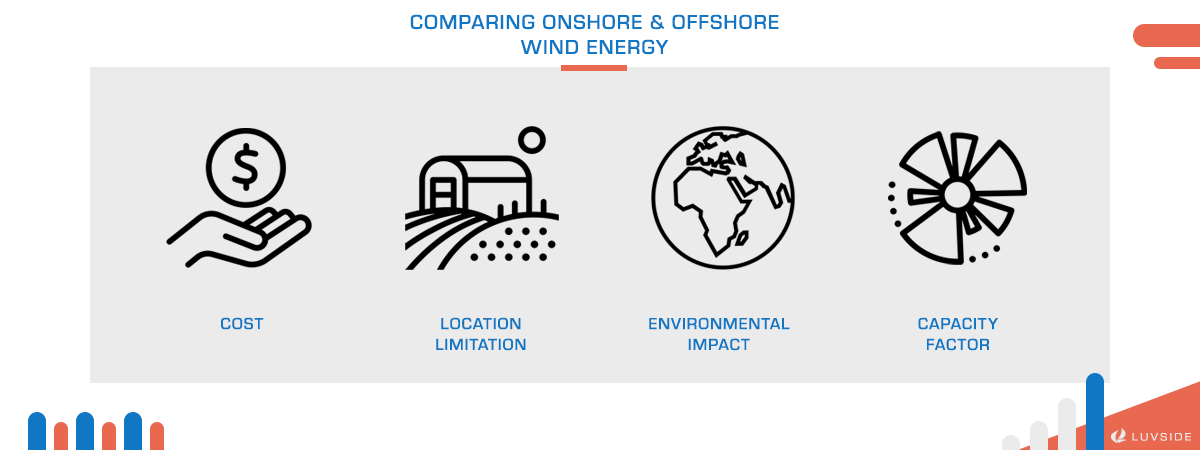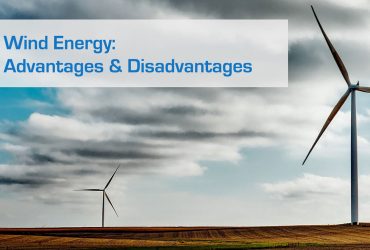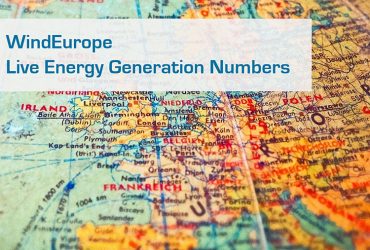
Offshore and onshore wind farms compared
Wind farms can be built both onshore and offshore to harvest wind energy and generate sustainable electricity. The difference between the two locations comes with different advantages and disadvantages. In recent years, increasing constructions of onshore and offshore wind farms lead to more and more related discussions. What are onshore and offshore wind energy exactly and what comes with them?
Onshore wind energy is wind energy on land
Onshore wind turbines are turbines built on land. The very first onshore wind turbine built to generate electricity dates back to the 19th century. The types of wind turbines used for onshore operation span from all sizes of horizontal axis wind turbines, which resemble fans, to smaller vertical axis wind turbines that are shaped like fusilli pasta. The power outputs of onshore wind turbines range from 4.8 MW— the world’s largest onshore horizontal axis wind turbine, GE 4.8-158— to as small as 10 W.
Depending on the type of wind turbines in question, onshore wind turbines can be set up individually on fields, coastal areas, mountain tops, or even the backyard of a household. They can also be grouped to form a wind farm that delivers larger, collective power output. Modern onshore wind farms using large horizontal axis wind turbines can consist of thousands of turbines. The world’s largest onshore wind farm located in China has a planned power capacity of 20GW.
Offshore wind energy is wind energy over waters
Offshore wind energy refers to when wind over large water bodies like the ocean is used to generate electrical power. Offshore wind turbines are usually some of the largest, most powerful horizontal axis wind turbines in the world, built directly in the oceans and far away from the coast. With up to several hundreds of them, offshore wind farms are capable of generating hundreds of megawatts. The generated electrical power is transmitted over large distances to land, where it can be utilized.
Vertical axis wind turbines can also be installed in an offshore environment. Unlike horizontal axis wind turbines, offshore vertical axis wind turbines are mostly installed on existing offshore platforms and used to supply electricity directly to the offshore work stations.
Advantages and Disadvantages of Onshore and Offshore Wind Energy
Due to the completely different nature of their locations, onshore and offshore wind energy have almost opposite advantages and disadvantages. The advantages and disadvantages of onshore and offshore wind energy can be discussed from four perspectives: Cost, location limitation, environmental impact, and capacity factor.

Costs
Compared to offshore wind farms, the cost of onshore wind farms are relatively cheap. Onshore wind farms require simpler transportation logistics and installation processes because they are located on land. The wind turbines can also be produced nearby, boosting the local economy and reducing emissions of transportation to their final location. Since the weather condition is calmer on land, the wind turbines experience less wear-down and thus require less maintenance.
On the other hand, offshore wind farms are more expensive to build and maintain due to their hard-to-reach locations away from the coast. The turbines have to be shipped across long distances to be set up. The infrastructure to transmit the harvested energy is extensive, creating more CO2 emissions. They are also exposed to very high-speed winds from hurricanes and ocean weathers, increasing wear-down and risks of damage. When the turbines need to be maintained or repaired, technical workers and equipment have to travel a significant distance to reach the turbines, which increases the cost and the downtime of the turbines.
Location Limitation
Onshore wind farms often face limitations for installation because of their sight and noise emission. It is forbidden to build wind turbines in certain areas where natural preservation is the priority or residential conditions must be considered. There are also a number of local legal standards, such as the setback distance from residence, noise emission, and drop shadows, that need to be comply with before installing a wind turbine.
On the contrary, since offshore wind turbines are placed out of sight in the ocean, they face much less opposition from residents. Since they are in the sea, they are far less intrusive to neighboring counties, allowing larger wind farms to be built.
Environmental Impact
While onshore wind turbines are often regarded to pose threats to flying animals like birds and bats, the impact of offshore wind turbines to marine ecosystems is still a question yet to be answered. Until now, the scientific world does not have enough existing data to analyze how offshore wind turbines change marine environments.
Capacity Factor
Compared to offshore wind turbines, onshore wind turbines are more likely to have lower capacity factors because of their surroundings. The incoming wind they receive might be slowed down by nearby natural landscapes like forests or hills, or blocked by man-made structures like buildings or towers. These obstacles affect incoming wind speed or create turbulent wind conditions that are not optimal for operation, which in turn decreases power output performance of the wind turbines.
Offshore wind turbines don’t experience such problems. There is no obstacle over open water that could block or disturb wind activity. Wind over oceans are thus stronger and more consistent, resulting in much greater energy production at higher efficiencies for each turbine.
For example, as shown in the annual report conducted by WindEurope, onshore wind farms in Europe have an average capacity factor of 24% while offshore wind farms reach 38% of their capacity in 2019.
Offshore wind energy as a global trend
Currently, most of the offshore wind farms around the world dott the North Sea and Baltic Sea, scatter along the Chinese coast as well as pretty much surround England. The 2019 Offshore Wind Outlook by the International Energy Agency states that European Union countries together with the United Kingdom will remain world leaders in offshore wind technology for the next two decades, with China being a close second. According to WindEurope, offshore wind energy in Europe has a total power capacity of 22 GW in 2019. Aside from an expansion of the European and Chinese wind farms, projects in Taiwan, Japan, and on the United States east coast are also underway or in construction.
Related Content
Europe is expanding its offshore wind farms dotting the North Sea while China keeps adding more and more turbines to the world’s biggest wind park...
Renewable energy is, without a question, one of the European Union’s biggest development goals in the 21st century. Between 2004 and 2017, the share of...

